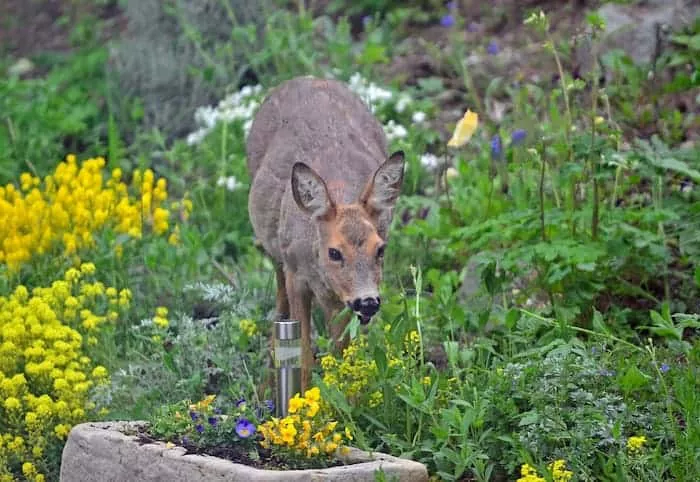Deer are common herbivores in nature, and their diet is mainly plant, including leaves, buds, herbs and flowers. Although deer will eat a wide variety of plants, not all flowers will suit their tastes. Some flowers are actively avoided by deer for reasons such as taste, toxicity or texture. This article will detail the flowers that deer do not like to eat, and explore why these plants are not popular with deer.
Overview of deer eating habits
Deer are herbivores and their diet is very varied. Deer will choose different plants for food according to the season and environment. In spring, for example, deer like to eat young leaves and flowers; In the summer, they turn to herbs; In autumn, fruits and seeds become the main food; In winter, deer rely on bark and dead leaves.
Deer’s dietary choices are not only related to the availability of food, but are also influenced by nutritional requirements and plant characteristics. Deer need enough protein, carbohydrates and minerals to stay healthy, so they choose plants that are high in nutrition and easy to digest.
Deer do not like the type of flowers
Flowers with a strong smell
Many flowers are disliked by deer because of their strong smell. For example:
Lavender: The scent of lavender is very pleasant for humans, but too pungent for deer. Deer usually avoid this plant.
Rosemary: The strong aroma of rosemary also makes deer uncomfortable, so they rarely eat this plant.
Poisonous flower
Some flowers contain toxins, and deer instinctively avoid these plants. For example:
Daffodils: Daffodils contain a toxin called lycorine, which is harmful to deer’s digestive system.
Oleander: The toxins of oleander can be deadly to deer and other animals, and deer will stay away from this plant.
Coarse or prickly flowers
Deer do not like rough or prickly flowers because these plants are difficult to chew and digest. For example:
Cactus flowers: The spines of cactus make deer uncomfortable, so they will not eat this plant.
Roses: Although the flowers of roses are beautiful, the thorns on their stems will frighten deer.
Why don’t deer like these flowers?
The effect of scent on deer
Deer have a very sensitive sense of smell, and they will judge the safety of food by smell. Flowers with strong odors are often uncomfortable for deer, so they choose to avoid these plants.
The danger of toxins to deer
Deer have evolved over a long period of time to recognize and avoid poisonous plants. Eating poisonous flowers can lead to deer poisoning and even death. As a result, deer instinctively stay away from these plants.
The effect of texture and taste
Deer like plants that are soft and easy to chew. Rough or prickly flowers are not only difficult to chew, but may also cause harm to the deer’s mouth and digestive system. As a result, deer avoid eating these plants.
Examples of common flowers that deer dislike
Lavender
The scent of lavender is very attractive for humans, but it is too strong for deer. Deer usually avoid this plant, so lavender is often used as a deer-repellent plant.
daffodil
Daffodils contain lycorine, a toxin that is harmful to deer’s digestive system. Deer will instinctively stay away from the plant to avoid being poisoned.
oleander
Oleander’s toxins are deadly to deer and other animals. Deer stay away from the plant for their own safety.
Rose
Although the flowers of roses are beautiful, the thorns on their stems can make deer uncomfortable. Deer usually avoid this plant in favor of other, softer foods.
Effects of deer’s dietary choices on plants
The effect of deer not eating flowers on plant reproduction
Deer not eating certain flowers may make it easier for these plants to reproduce. Lavender and daffodils, for example, are able to flower and set seeds more smoothly because they are not welcomed by deer.
The ecological balance between deer and plants
The deer’s dietary choices have an important impact on the balance of the ecosystem. By avoiding certain plants, deer can help those plants grow and reproduce better, thereby maintaining ecological diversity.
Effects of deer diet on plant diversity
The deer’s eating habits help control the overgrowth of some plants, thereby providing space for others. This selective feeding behavior is essential for the maintenance of plant diversity.
How can deer’s eating habits be used to protect gardens
Grow plants that deer don’t like
If you want to protect your garden from deer, plant plants that deer don’t like, such as lavender, rosemary, and daffodils. Not only are these plants beautiful, they are also effective at repelling deer.
Use natural deer repellents
In addition to growing plants that deer don’t like, natural deer repellents such as pepper spray or garlic spray can be used. The smell of these natural substances will make deer uncomfortable and stay away from your garden.
Design a garden layout that deer are not interested in
By choosing plants that deer don’t like and designing a reasonable garden layout, deer infestations can be effectively reduced. For example, planting plants that deer don’t like at the edge of a garden can act as a barrier.
Conclusion
Deer are beautiful and important animals whose eating habits not only affect their own survival, but also have a profound impact on ecosystems. By understanding what flowers deer don’t like to eat, we can better protect gardens and natural ecosystems.


